Menus
- Diesel does differently
- Turbocharged diesel parallel twin, 1,430 cm3, 94 hp and 175 Nm, 270 kg dry, 68,500 euros
- Genesis
- Discovery
- In the saddle
- Test
- Conclusion
Diesel does differently
Turbocharged diesel parallel twin, 1,430 cm3, 94 hp and 175 Nm, 270 kg dry, 68,500 euros
Let’s face it, we bikers have a particularly negative opinion of diesel engines, usually associated with the painful consequences of encountering an oil stain dropped by a truck or bus.. And to this is added the scandals related to cars powered by the compression ignition engine invented by the German engineer Rudolf Diesel in the 1890s..
Since then, the diesel engine has nevertheless established itself as a mainstay of maritime transport, rail transport, public transport, road transport or even stationary use. Basically, these are all the applications where its advantages in reducing fuel consumption by 30% and longer life compared to a gasoline internal combustion engine using the Otto principle (using a spark plug). ignition), make it possible to sufficiently compensate for its drawbacks of additional noise and vibrations, higher manufacturing costs and above all greater bulk and weight. All this while allowing the use of cheaper non-fossil fuels (Rudi ran his first engines on peanut oil). Yet diesel engines require a heavier and more robust construction, which makes them unsuitable for certain applications such as airplanes and, until now, motorcycles. Yes, but that was before. And the Neander 1400 proves that nothing is impossible, not even the implausible. Testing a non-standard motorcycle, at all levels.
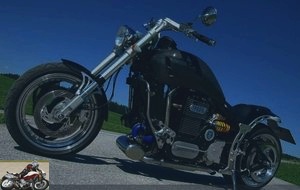 Neander 1400 Turbodiesel review
Neander 1400 Turbodiesel review
Genesis
But a little step back is in order. Two decades ago, Germany’s Neander Motors intended to change all that, with a new 1,430cc turbocharged parallel twin-cylinder diesel engine developed for them by Rupert Baindl, one of the world’s most innovative motorcycle engineers. modern era. This bearded Bavarian has traditional engineering skills backed by a comprehensive knowledge of digital technology. He has a perfect command of the manufacture of complex metal components in his machine shop. He is so mastered that he designed it himself in CAD using finite element analysis programs. Baindl has thus carved out a master’s place among the top technicians to create the incredible BMR 741 cm3 racing car with which Katjia Poensgen won the European Supermono Championship in 1998..
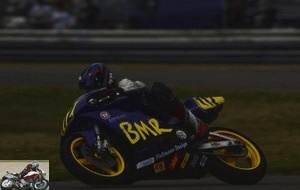 Katja Poensgen on the BMR Supermono
Katja Poensgen on the BMR Supermono
Embodying the free-thinking fertility of the monos category, the injection BMR was almost entirely handcrafted by Baindl and his pals. This bike especially gave off more power than any other single-cylinder with 92 horsepower at 8,100 rpm and enough in any case to send my factory Ducati Supermono to the last step of the podium during the Hockenheim round on the sidelines. of the 1996 WorldSBK when private GP 500 Michael Rudroff gave Baindl’s bike his first European Championship victory. I haven’t forgotten Rupi’s promise to me that day as we shook hands on the podium after the sparkling watering:
I’m working on something even more special than the BMR and when it’s ready I would like you to ride it. Just be patient… !
Well, I haven’t forgotten, although I started to think Rupi did until a phone call away a few years later. He invited me to come to Germany to test the result of a concept that had undergone several transformations from its original form. Because the Baindl engine indeed started as a 750 cc single cylinder for the BMR Supermono and built to deliver 112 hp at 12,000 rpm according to Rupi. Then the bike turned into a 990cc parallel-twin project for MotoGP … which never got past the CAD stage. And from there we went to the prototype of the world’s first production turbodiesel motorcycle.
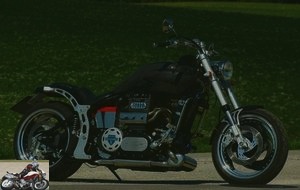 The twin was originally intended to be a MotoGP 990 before being upgraded to a diesel
The twin was originally intended to be a MotoGP 990 before being upgraded to a diesel
But why call an oil burner Neander? In reference to supposedly Stone Age technology? No, but rather to mark the rebirth of a brand that was one of the best known in Germany in the pages of motorcycle history books. Because it was Ernst Neumann-Neander who, from 1924, sold a range of unorthodox motorcycles including a pressed steel frame, leaf suspensions and a bucket seat, with their bundle of innovations. These were manufactured under license by the Opel car factory which took over their design in 1928 when Neander went bankrupt due to the crisis. Opel stopped making motorcycles in 1930, but not before Fritz von Opel attached a seemingly six rocket ship to his Opel Neander 500 in search of more sparkling acceleration…
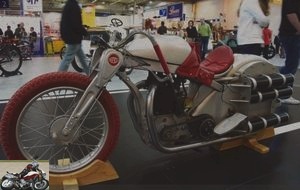 Fritz von Opel’s rocket Neander
Fritz von Opel’s rocket Neander
Discovery
Three quarters of a century later, the revival of the Neander brand is due to the German promoter Phillip Hitzbleck, with an engine inspired by Baindl as unconventional as the Opel rocket of the time. Indeed, the incredible diesel machine that was waiting for me to drive one summer afternoon in the Bavarian countryside south of Munich, pretending at first glance to be an American cruiser with a big parallel twin, was a motorcycle unlike any other and not just because of its choice of fuel.
 At first glance, the Neander looks like a very stylish cruiser
At first glance, the Neander looks like a very stylish cruiser
The large parallel twin engine is 1,430 cc air / oil cooled with 108 x 78.2 mm cylinders and counter-rotating crankshafts mounted in a cross, gear-coupled and each carrying two connecting rods. Each pair jointly supports a three-segment, lightweight steel piston with ultra-short skirts via two offset axles, so that there is minimal side thrust like on a conventional engine, reducing friction and wear, despite the compression ratio of 16: 1.
At the top of this very robust and innovative design is an equally unique 8-valve dual overhead cam cylinder head with four radial valves per cylinder (35mm intake and 30mm exhaust).
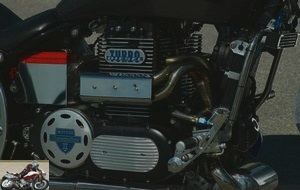 The turbocharged twin-cylinder diesel has a displacement of 1,430 cm3
The turbocharged twin-cylinder diesel has a displacement of 1,430 cm3
The Neander’s intake duct is here channeled vertically in the center of the cylinder head, between the two shafts, while the four exhaust valves each supply dedicated manifolds (2 at the front and 2 at the rear of the engine) , which gives the illusion that the large enough engine is a four-cylinder when it is not. These are jointly fed into a single Garrett turbocharger with intercooler delivering 1.4 bar boost pressure to the airbox containing the 31mm throttle body, then into a three-way catalyst mounted at the bottom of the engine. ‘front of the engine, before finally exiting through the two lowered exhausts on either side of the engine. The Bosch electronic fuel injector uses a simple top 6-hole injector, but a fuel cooler located in front of the steering column is required to prevent firing due to heat transfer from the combustion chamber.
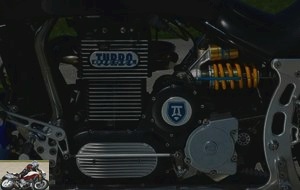 On this prototype, the engine develops 94 hp and 175 Nm
On this prototype, the engine develops 94 hp and 175 Nm
Equipped with a 6-speed gearbox using Aprilia RSV1000R gears with a dry multi-plate clutch, primary gear and Gates toothed belt final drive, this literally unique powertrain weighing 108 kg dry, delivers as per its designer 94 horsepower at 4,200 rpm and an impressive torque of 175 Nm at just 2,600 rpm, values more in line with the expectations of a light utility !
Conversely, the chassis of the Neander Turbodiesel is just as conventional as its original engine, with the twin-cylinder inserted in a classic single-beam frame of tubular chrome-molybdenum steel designed by German customization specialist Gunther Zellner. The fully adjustable Ohlins rear monoshock is pretty radical by cruiser standards, but matched with a Paioli 43mm inverted fork with 31 ° castor angle and 109mm castor, the set boasts a long wheelbase of 1,740mm. . Lester Lutz, CEO of Neander, said the company was considering offering a 1,950mm version as an option when production of the first limited edition of 50 was to start with a price tag of 68,500 euros (but would they have installed a step rear to exit its parking lot with such a long machine?).
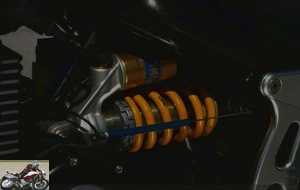 The chassis is more conventional like the fully adjustable Цhlins cantilever.
The chassis is more conventional like the fully adjustable Цhlins cantilever.
Weighing 270 kg dry, the Neander stops its top speed of 230 km / h by a trio of 300 mm steel discs gripped by four-piston Performance Machine calipers. The American aftermarket specialist also delivers the aluminum rims fitted with Metzeler Marathon tires, the huge 240 / 40-18 rear of which does not help handling, but adds cachet to the look..
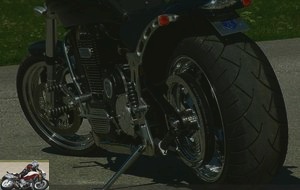 Cruiser obliges, the rear tire is oversized
Cruiser obliges, the rear tire is oversized
In the saddle
Passing one leg over the low 650mm seat of the Neander Turbodiesel is easily done before ending up on a relatively soft seat even if the passenger’s jump seat on the rear fender plays only a symbolic role..
 The saddle is quite comfortable, we can not say the same about the patch used to accommodate the passenger
The saddle is quite comfortable, we can not say the same about the patch used to accommodate the passenger
It looks like a typical American powercruiser, offering a relaxed stance with the feet very forward and the hands perched high to grip the unusual and very design handlebar that rises straight above the triple upper triple tree of the Paioli fork with a small round counter integrated into each of the two supports. On the left is the speedometer graduated up to 260 km / h and on the right a quartet of warning lights corresponding to the indicators, headlights, neutral and oil level.
 The raised handlebars have an original design to say the least
The raised handlebars have an original design to say the least
The MoTeC digital telemetry unit, commonly found on Superbikes and GPs, mounted to the front of the bike’s carbon fiber trim that houses the 10-liter tank and matching hardware indicates that it is indeed a prototype. Its use for data collection would not be necessary on production motorcycles, although the missing fuel gauge is, although the Neander’s incredibly frugal fuel consumption (advertised at 3 l / 100 km) means that one does not have to stop too often at gas stations and that if you run out of fuel somewhere in the countryside, you can always look for a tractor to siphon off a liter of diesel !
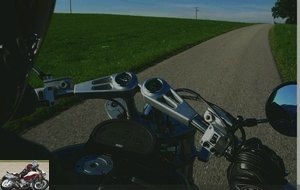 The instrumentation is based here on two dials in the handlebars and a digital screen above the tank
The instrumentation is based here on two dials in the handlebars and a digital screen above the tank
Nothing then suggests the surprise that reserves the bike when you press the start button on the right handlebars..
Test
But grab the ignition key behind your right leg, turn on the fuel valve when the pump starts to hum, press the start button (no need for preheating like on old diesels), and brace yourself for a shock. Because it’s not a powercruiser like any other. It’s not only ready to roar when it engages on the freeway, it does it from the moment the starter fights against the roughly 16: 1 compression as soon as those huge bore pistons kick in. of 108mm, persuading the twin turbodiesel to come to life. The muffled, lumpy sound that comes out of the low mufflers as the engine settles into idle at 950 rpm is quite different from the tone of any normal motorcycle. But this totally distinctive melody is not accompanied by any perceptible vibration. The Neander is strangely still, both in slow motion and in motion, no matter how hard you take it. As in, NO vibrations !!
 The Neander is devoid of any vibration
The Neander is devoid of any vibration
Select the lower gear and slowly release the light clutch lever to start. While the Neander doesn’t really accelerate smoothly, it still isn’t brutal, at least until the MoTeC dashboard tachometer reads around 2,000 rpm and the turbocharger starts to do. its work as overeating increases. There is then a delicious rise in power with the torque curve peaking at 2,600 rpm, but then remaining practically horizontal up to the power ceiling of 4,200 rpm, when the power and especially the torque then drop very markedly. Baindl said, however, that the engine could run up to 7,000 revolutions in complete safety..
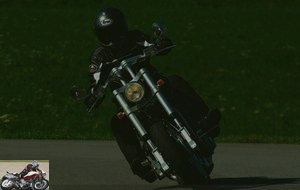 The torque of 175 Nm is almost constant from 2,600 to 4,200 rpm, then drops significantly
The torque of 175 Nm is almost constant from 2,600 to 4,200 rpm, then drops significantly
What you should definitely not do is let the deceptive clicking sound of the diesel engine make it seem like you should run it everywhere at low revs. We CAN do it, of course, ry it’s a perfect bike for strolling in the streets, but then we sacrifice the "sport" part of the sportcruiser package that this Neander presents because the turbo is off boost. But when you persuade yourself to push it, the Neander comes to life to the sound of the faint whistle of the Garrett turbo, which can be distinguished above the still noticeable rattle of the diesel engine, delivering quick and powerful acceleration despite the weight at hand. dry 270 kg (295 kg with all fluids) which makes you happy to have that wide rear tire, at least for straight line acceleration…
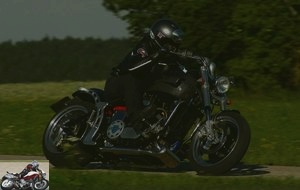 If the engine resumes after 2,000 revolutions, it is better to push it to take advantage of the turbo
If the engine resumes after 2,000 revolutions, it is better to push it to take advantage of the turbo
But the biggest surprise, once you adjust your mindset to accept driving a diesel motorcycle, lies in the speed at which this engine revs, thanks in particular to its short-stroke configuration and reduced friction. . Coupled with the relatively short range of power and especially torque, we find ourselves using the Aprilia 6-speed gearbox much more often than what we might expect from a diesel, if of course we drive the Neander. like the sportcruiser she’s meant to be.
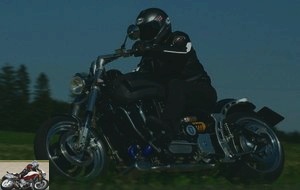 It is necessary to use the Aprilia gearbox a lot
It is necessary to use the Aprilia gearbox a lot
I have regularly seen the odometer read 160 km / h at just 2,820 rpm during my trip to Bavaria. And thanks to the driving position which remains rational, I had no trouble getting there. So imagine that it was indeed a true turbodiesel 240 km / h devouring kilometers for driving in real conditions. This was to be expected from a machine Made in Germany, the land of autobahnen without limitations. But here as everywhere else, the Neander would have been a very suitable base for a long-distance road with its limited consumption, its great torque and its absence of vibration. The Turbodiesel is comfortable and does not tire no matter the distance and the relatively low center of gravity of the engine also results in fairly smooth handling, capable of making quick turns or very tight hairpin turns on the hillside, although the ‘we can never forget that massive wheelbase.
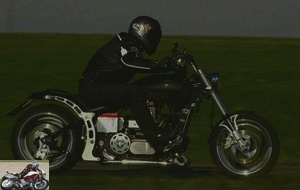 Announced with a maximum speed of 240 km / h, the Neander is a machine made for the Autobahn
Announced with a maximum speed of 240 km / h, the Neander is a machine made for the Autobahn
Really, the only downside to this very avant-garde set is the noise made by the engine, frankly not pleasant, especially at full load when the level of mechanical noise increases really significantly. It’s really not a motorcycle that you want to bring home late at night to continue to get along well with your neighbors. But I guess the same can be said of any Harley-Davidson that went through Stage 1. Anyway, the problem isn’t so much that the engine itself is noisy, but that the sound of the turbo-diesel is just not melodic or sophisticated when ridden, especially compared to conventional motorcycles costing a tenth of the price of the entry ticket for the Neander.
Conclusion
By all accounts this motorcycle was a surprise, not only for its unique mechanical format, but also for the efficiency with which it applies the benefits gained from a decade of diesel engine development to the motorcycle..
Rupert Baindl:
The research manager of the Bosch Diesel development department told us that this concept would never work. He’s a motorcycle fan, so when we rode the Neander we asked him to come and ride it. He was gone for two hours and returned asking to buy one on behalf of Bosch. He said they had to take a look at it and find out how we had achieved the impossible! It was a nice compliment…
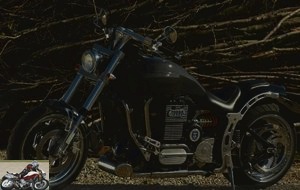 Although widely revised for its production version, the Neander paid a high price for its price and the negative image of diesel
Although widely revised for its production version, the Neander paid a high price for its price and the negative image of diesel
Indeed, to the point that Audi decided to respond to the fact that nearly 50% of passenger cars sold were now diesel powered, by winning the 24 Hours of Le Mans with a 700 horsepower diesel engine racing car powered by fuel. diesel biofuel comprising an ingredient cocktail of up to 50% soybean, rapeseed or jatropha oil. It was then appropriate and opportune that the question of the future motorcyclist of this type of engine be asked. Rupert Baindl and the management of Neander Motors have bet so. Few followed them partly because of the high price of the motorcycle but also because the diesel engine quickly fell out of favor for environmental reasons. Lester & Co. ultimately redeveloped this engine for a marine application. Despite everything, this test remains historic because we rarely have the opportunity to try such extraordinary motorcycles….
Strong points
- No vibrations
- Engine approval
- Maneuverability
- Comfort
Weak points
- Short usable speed range
- Rear tire too wide
- Mechanical noise
The technical sheet of the Neander 1400 Turbodiesel
Related articles
-
Kawasaki 1400 GTR motorcycle test
THE GT There always comes a time when every motorcyclist wonders about the positioning of his passion. And the current offer, with its various…
-
Kawasaki ZZR 1400 motorcycle test
The Very High Speed Motorcycle according to Kawasaki We do three kilometers at 200 then at my signal, we open wide. Sitting next to me, assayer Kawa…
-
Moto Guzzi California 1400 custom test
The myth revisited If for you the Moto Guzzi California only evoked pure tourism, the new 1400 Custom will make you change your mind ….. Tackling a…
-
Cruise missile The ultimate breed of sports cars, the Kawasaki ZZR 1400 is a living myth; the last witness to an almost vanished age when speed and power…
-
Moto Guzzi California 1400 Touring test
The Italian-American star makes his comeback Unmissable motorcyclist reference, the Italian brand, completely revisits one of its most emblematic models:…
-
The European Grand Prix prototype 108 ° V4, 499 cc, 192 hp at 12,500 rpm, 129 kg We find it normal to see Ducati, KTM and Aprilia currently competing in…
-
Test MV Agusta Turismo Veloce 800 Lusso SCS
A very high-end and very techno vision of fast tourism 3 cylinders in line, 798 cm3, 110 hp at 10,150 rpm, 80 Nm at 7100 rpm, 192 kilos, € 21,490 Be…
-
Yamaha RZV 500R motorcycle test
GP 500 2 stroke … road ! 50 ° V4, 494 cc, 100 hp, 134 kg Sports bikers are familiar with the Yamaha RD 500 LC, inspired by Kenny Roberts’ YZR500….
-
MV Agusta Superveloce 800 motorcycle test
Neo-retro in the right tempo 3 cylinders of 798 cm3, 148 hp, 88 Nm, 173 kg, 20,300 euros Concept bike adapted in an ultra exclusive limited series, the…
-
Curtiss P40 Warhawk Final Edition motorcycle test
First and last 2.163 cc V-Twin, 156 hp and 217 Nm, 247 kg full made, $ 75,000 Curtiss Motorcycle Co. , named after legendary American biker and aviation…
Definitely, I would never get used to this praying mantis style before.
High and often poorly padded saddle requiring a comfortable saddle.
Adventure is not synonymous with motocross. Forbidden to the majority of women and those under 1.80 m.
Too bad considering the quality of KTM it would be the ideal companion for many people, apart from the aesthetics
A matter of taste certainly, but the front scares me away. Height dissuades me and yet I am taller than average. It is a mono, must like, it is not very versatile. Consumes more with more frequent service than a 48 horsepower CB500X at the same price. Better offroad? Certainly, but the offroad is totally illegal in France. Yes, even on private roads, see the ONCFS website. The only exception is the land declared in town hall as enduro land. I know it stings but it’s the law, 1500 € and immediate confiscation of the vehicle if you cross a field or take a forest track. Considering the purchase price it hurts …
That’s good, she came out 20 years ago .
.
A municipal road as there are many is suitable for all traffic except by order of the town hall and restriction, or even prohibition..
Often it is the new residents who do not support the passage of quads or motorcycles.
Conversely, we have had problems with quads which have damaged by claiming their right of way..
Morality the path is closed because of idiots
Laurentg, finished the 690 in the range !
Picabia, I measure 1m66 and have so far done 92000 km without problem even with 2 loaded with my KTM SMT, so less than 1m80 do not refrain from trying this 390!
Bee loo my wife and my daughter are 1.60 and I don’t think the feet would be flat on the ground with an 85 cm saddle.
I am 1.76 m tall and on my Honda trail I was on tiptoe (with a comfort saddle)
Bee Loo no the 690 range is not finished, still in the KTM 690 SMC R 2020 catalog recommended retail price including VAT: 11.099,00 EUR more the 690 is also on the Husqvarna (701).
Malas, after a 990 SMT, I switched to the 1190 Adventure and now the 790 Adventure and yet my bikes have never put a tire in the mud, I just like the trail riding position, the comfort of the suspensions and their part cycles (and I’m not talking about sublime KTM engines). Given the state of the secondary network, it’s great. For me if you want something efficient in the paths there are enduros made for that. After the saddle height it’s one thing, you also have to see the smoothness of the saddle and the tank, I put my feet better on the ground on my 790 Adventure (830 mm) than on my Z900RS Cafe (825mm) because the Kawa (secondary motorcycle) has a much wider saddle.
Sorry Laurentg I forgot the SMC, thank you for correcting! For the 701 I know, I have one LOL
Picabia no of course the feet would not be flat, what I mean is that it does not prevent the choice of this bike, you have to be mobile on the saddle and it does..
Uh no: always, the amateur of "noble mechanics" spits on diesel .
.